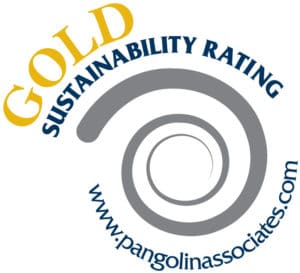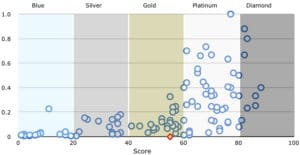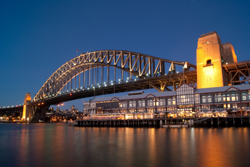- Reduce your energy bill by 20% or more – see our sucess stories:
- LEDs. Where to now?
- Acresta: a new partnership, CarbonView carbon accounting software
- Get ranked – Pangolin Sustainability Badges
- Sydney Theatre Company – creating a Green Indices
- Team focus – Mike O’Neill: energy, NCOS & LCA specialist
Miss our last newsletter?
Reduce your energy bill by 20% or more

Last newsletter we told you about energy grants available from federal and state governments. Savings through energy efficiencies continues to be a major concern for our clients. We thought we would tell you about a few successes, but first, here are results based on our 20 most recent Energy Audits:
- Average annual savings $157,356
- Average recommendations return on investment 3.7 years (without energy grant funding)
- Average total energy saving 27.4%
See a few success stories below:
- Techno Plas an Australian manufacturer exporting plastics into China, yes it is possible! Techno Plas reduced power usage through equipment upgrades.
- RM Williams achieved savings of 21% (over $66,000) through an Energy Audit.
- FB Rice finds surprise savings through energy efficient lighting.
Techno Plas: upgrading equipment
 Techno Plas is an Australian-owned specialist moulding manufacturer based in South Australia. Through energy efficiency measures, the company has not only saved substantially to the bottom line, they’ve turned export on its head. Techno Plas cost effectively exports commodity plastic productions into China.
Techno Plas is an Australian-owned specialist moulding manufacturer based in South Australia. Through energy efficiency measures, the company has not only saved substantially to the bottom line, they’ve turned export on its head. Techno Plas cost effectively exports commodity plastic productions into China.
An early mover, Techno Plas undertook Pangolin’s Energy Audit in 2011, part of the state government’s Business Sustainability Alliance program (BSA). Following the audit the company was able to apply for and receive $212,740 in government funding under the Clean Technology Investment Program (CTIP).
Grant funds assisted in the purchase and replacement of 20 percent of key equipment. Techno Plas now processes over 50 percent of raw material with power usage savings on average of 60 percent. Additionally, the CTIP grant effectively halved the payback period for upgrading to an electric injection moulding machine.
Techno Plas has now submitted a second funding application. With good, viable projects, subsequent grant funding is possible.
RM Williams: voltage optimisation
 RM Williams’ manufacturing base has expanded significantly over the last decade. The organisation needed to act on sustainability for productivity and energy efficiencies that could underwrite its manufacturing capacity growth.
RM Williams’ manufacturing base has expanded significantly over the last decade. The organisation needed to act on sustainability for productivity and energy efficiencies that could underwrite its manufacturing capacity growth.
A comprehensive Energy Audit identified recommendations with significant results:
- Energy savings of approximately 21% percent per year,
- Cost savings of more than $66,000 per year,
- A payback period of less than 3 years.
Increasing the actual capacity of electricity supply to the site was a key part of the project. In summer peak production lines were simply shut down as the main transformer would otherwise trip. Excess loads caused the manufacturer costly outages.
We recommended our Energywise partner for the voltage optimisation technology and power factor correction to the site. Early reports indicate that not only has the manufacturer avoided the costly exercise of upgrading their transformer (no payback, just increased capacity), they now have additional site capacity for further expansion.
Funding available
Pangolin’s Energy Audit also made RM Williams eligible for a grant through South Australia’s Business Sustainability Alliance program (BSA).
FB Rice: energy efficient lighting
 FB Rice is a well-established IP legal practice with offices in Sydney and Melbourne.
FB Rice is a well-established IP legal practice with offices in Sydney and Melbourne.
The firm realised that a single energy efficiency action could bring unexpected savings. Pangolin’s energy auditors recommended that FB Rice replace energy intensive halogen downlights for more efficient LEDs, an action primarily to reduce energy costs.
The unexpected secondary cost saving came from associated bulb replacement fees. Typically the firm’s halogens with a short life span blew out twice a year. As part of FB Rice’s lease agreement, building management charged a fee of $65 per callout, which as bulb after bulb blew (approximately 1 per week) became a significant cost. With a 15 – 25 year lifespan LEDs all but removed that annual expense.
At just under $100 per LED light (a great deal more expensive than today’s prices), FB Rice realised a payback at approximately one year.
Typically LEDs use 80 – 90% less power than conventional halogen globes.
LEDs. Where to now?
 Pangolin’s Director of Audit and Research, Dr Davide Ross, is our resident LED expert. His article for the Hotel Engineer Magazine (March 2013) considers whether companies should replace now, or wait for greater efficiency and less cost. Davide says LED’s will continue to get brighter, cooler, more efficient and less expensive. He adds that LEDs will in time become the dominant lighting technology in the market, displacing others.
Pangolin’s Director of Audit and Research, Dr Davide Ross, is our resident LED expert. His article for the Hotel Engineer Magazine (March 2013) considers whether companies should replace now, or wait for greater efficiency and less cost. Davide says LED’s will continue to get brighter, cooler, more efficient and less expensive. He adds that LEDs will in time become the dominant lighting technology in the market, displacing others.
So should you wait? Davide writes:
“While our insatiable demand for contemporary computing power will continually grow until the physical limit of transistor count per integrated circuit is reached, we have no foreseeable reason in residential and commercial applications to strive to pack a bright glowing celestial star in a light bulb to brighten a dull room. A limit will be reached that does not need to be crossed.”
Acresta (now SimbleSense): a partnership
CarbonView carbon accounting software
 In May we announced a new partnership with Acresta (now SimbleSense) for CarbonView carbon accounting software. CarbonView is a fantastic complement to Pangolin’s carbon and energy management services and comes at an opportune time. It will give many of our clients greater control over environmental performance – and more convenience.
In May we announced a new partnership with Acresta (now SimbleSense) for CarbonView carbon accounting software. CarbonView is a fantastic complement to Pangolin’s carbon and energy management services and comes at an opportune time. It will give many of our clients greater control over environmental performance – and more convenience.
Developed in Australia, this is a cloud-based, enterprise-wide software tool. We see CarbonView’s potential for all sectors; it allows customisation of emissions sources, and easier management of emissions reduction objectives and carbon abatement projects. Its core capabilities include performance tracking and visibility across the enterprise and supply chain.
Who will use CarbonView
Large corporations with compliance reporting obligations:
Under Australia’s National Greenhouse and Energy Reporting Act (NGER), many large organisations must measure and report their energy use and carbon impact. They face strict regulations and timeframes.
All organisations interested in voluntary action or carbon neutral certification:
We’ve seen a significant rise in voluntary reporting to industry bodies and associations from all types and sizes of businesses. Greenhouse gas emissions measurement is also an essential step for organisations seeking carbon neutral certification under the National Carbon Offset Standard (NCOS). We have helped numerous organisations achieve carbon neutrality.
In all of these situations, CarbonView provides streamlined data collection processes and real-time reporting.
Get ranked
Pangolin Sustainability Badges
 We’ve had great interest in our Sustainability Badges. Ask us how you can earn a badge for your marketing materials, such as websites and tender responses, and for team building and morale.
We’ve had great interest in our Sustainability Badges. Ask us how you can earn a badge for your marketing materials, such as websites and tender responses, and for team building and morale.
We use Climate Counts criteria to rank your organisation’s environmental achievements. (We don’t make it up ourselves!) This is a 0 – 100 point system with 22 criteria to determine if you have:
- Measured your carbon footprint
- Acted to reduce your impact on the environment
- Publicly disclosed your actions
Climate Counts compares data against industry competitors. Here is a sample chart: the red diamond indicates the rating after analysis.

Sydney Theatre Company (STC)
Creating a Green Indices
 You’ve probably heard of ‘Greening the Wharf’. This is one aspect of the Sydney Theatre Company’s plan to protect the environment. The STC has a comprehensive sustainability programme, and as part of its advocacy wishes to accurately and clearly communicate their results.
You’ve probably heard of ‘Greening the Wharf’. This is one aspect of the Sydney Theatre Company’s plan to protect the environment. The STC has a comprehensive sustainability programme, and as part of its advocacy wishes to accurately and clearly communicate their results.
Wd created a Green Indices to meet this need. This method of documentation provides easily understood metrics for key environmental factors over a 5-year period (2007-2012): energy, water, waste, greenhouse gas emissions and timber.
We asked the STC’s Paul O’Byrne, Director, Community and Corporate Partnerships, to comment.
How does the Green Indices factor into your Greening the Wharf program?
“The measurement and reporting of STC’s green indicators is fundamental to understanding the impact of our Greening The Wharf program and ongoing internal behavioural change initiatives.”
Has it worked for you?
“The indicators are included each year in various communication channels, and are an important part of the Company’s ongoing accountability. By focusing on five key indicators, they enable STC to quickly communicate our green credentials and results.”
Was there anything that came out of the Green Indices that was unexpected or unidentified?
“The indicators give us the opportunity to see how we might build on our significant sustainability efforts.”
Team focus
Meet Mike O’Neill: energy, NCOS & LCA specialist
 Mike brings experience from the UK Carbon Trust Certification Team. This makes him a go to for Australia’s carbon neutral certification process. To date Mike has helped several Australian organisations achieve carbon neutrality under the National Carbon Offset Standard (NCOS). This is the only government endorsed certification of its kind, and it comes with stringent conditions.
Mike brings experience from the UK Carbon Trust Certification Team. This makes him a go to for Australia’s carbon neutral certification process. To date Mike has helped several Australian organisations achieve carbon neutrality under the National Carbon Offset Standard (NCOS). This is the only government endorsed certification of its kind, and it comes with stringent conditions.
In London Mike also helped companies with product carbon footprinting, expressly for the UK’s Carbon Reduction Label. Our clients benefit from that expertise too. At the moment he is working on product Life Cycle Analysis (LCA) projects. The aim is to reduce these products’ environmental impact to zero greenhouse gas emissions – or carbon neutrality.
Local council sustainability is another of Mike’s specialisations. He is currently working with a number of Sydney based councils on sustainability projects. In depth understanding of the issues affecting local government operations means he effectively tailors emissions reduction and energy efficiency programs for their specific requirements.
Mike joined Pangolin Associates as a Senior Consultant in Sydney in early 2012.
